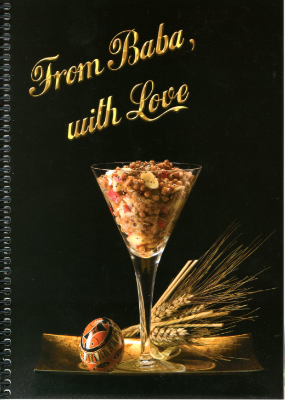Home / Shop
From Baba, with Love


- Description
Foreword to From Baba, with Love
Table of Contents
Part one: The Spiritual Seasons of Life
Spring and Summer Season Feast Days Graveside Visitations (Provody) Christian Burial Scaraments (Holy Unction) Autumn Season Feast Days Sacraments (Matrimony) Winter Season Feast Days Holy Baptism Holy Chrismation | 5 7 12 15 18 19 21 28 37 39 48 49 |
Part Two: Treasured Family Favorites
Soups, Salads & Sauces Breads and Rolls Cereals and Grains Main Dishes Vegetables & Side Dishes Cakes and Cookies Desserts and Square Preserves | 53 95 155 169 195 243 283 303 |
The Holy Supper is steeped in tradition and symbolism. It is an important manifestation of our Home Church. We begin the Nativity celebration with family members at home and, later continue in the parish community with members of the larger church family. Christmas Eve is a day of fasting to recall the hardship that Joseph and Mary endured on the road to Bethlehem.
The family gathers. A sheaf of wheat, known as the grandfather spirit (didukh), is part of the decor. It represents the spirit of the family's ancestors and the role of wheat as the staff of life. It is tightly bound to represent the unity of the family. The youngest child has the task of looking for the first star which symbolizes the trek of the Three Wise Men to Bethlehem. When it is seen, the Holy Supper begins. The table symbolizes the stable in which Christ was born. It is set with a scattering of straw, under a white or embroidered cloth. This represents the manger. One place setting is left empty to honor any family member that has departed in the past year. The customary centrepiece is a round braided bread (kolach). If three kolachi are used, they represent the Holy Trinity. The round shape indicates eternal life. The kolach features a lighted white candle. Together, they symbolize Christ who proclaimed Himself to be the Light of the World and the Bread of Life. In some regions, the kolach is a long braided bread (struts/ia).
The Holy Supper is comprised of twelve meatless dishes. Each course is dedicated to one of Christ's apostles. Following a prayer, the family is greeted with the traditional Christ is Born (Khrystos Rodyvsia). All reply Let us Glorify Him (Slavim Yoho). The first course is always kutia made from boiled wheat. It is mixed with honey, poppy seeds and, sometimes, nuts or raisins. The wheat is reminiscent of the bread served by Jesus at the Last Supper and the ties that Ukrainians have to the land. Other courses include borshch, fish dishes, varenyky, cabbage rolls (holubtsi), mushrooms and cooked beans. The meal concludes with a stewed fruit dish (uzvar). Traditional pastries are made with honey and poppy seed. Often, nuts and candies are retrieved by the young children from under the festive table.
Christmas Eve concludes with attendance at Vesper Services and the Divine Liturgy. Carols are sung which remind us that we are reaffirming the reality of our salvation while celebrating the birth of Jesus in Bethlehem.
From Baba, with Love, pages 42-43
In Ukrainian tradition, a traditional Resurrection Service is held at sunrise beginning with a procession around the church. The parishioners joyfully sing the traditional Easter greeting Christ is Risen (Khrystos Voskres). The traditional reply is Truly He is Risen (Voistyno Voskres). Weather permitting, baskets of traditional Easter food are blessed outside following the Easter morning services. The baskets, covered with traditional embroidery, contain an array of meticulously prepared food. The blessing consists of a short prayer service by the priest who sprinkles the foods in the baskets with Holy Water. These foods are brought home and then eaten to "break the fast" of the early morning Easter hours.
Easter Dinner
The Easter Holiday table is representative of spring and is very colorful. The Paska, decorated with a blessed pussy willow branch, is placed in the center of the table which is covered with a white cloth and adorned with embroidered towels (rushnyky). A wax candle is inserted in the Paska. Colorful pysanky also adorn the Paska plate. The table is laden with the blessed food and other food items which could include the following:
- Roast pork
- Baked ham
- Homemade sausage
- Head Cheese (Studenets)
- Cabbage Rolls (Holubts)
- Mashed Potatoes and Gravy
- Easter Noodle Casserole
- Vegetables
- Salads
- Cheese Cakes or Tortes
- Beverages
- All these foods would be served during Easter week.
From Baba, with Love, pages 9, 11

